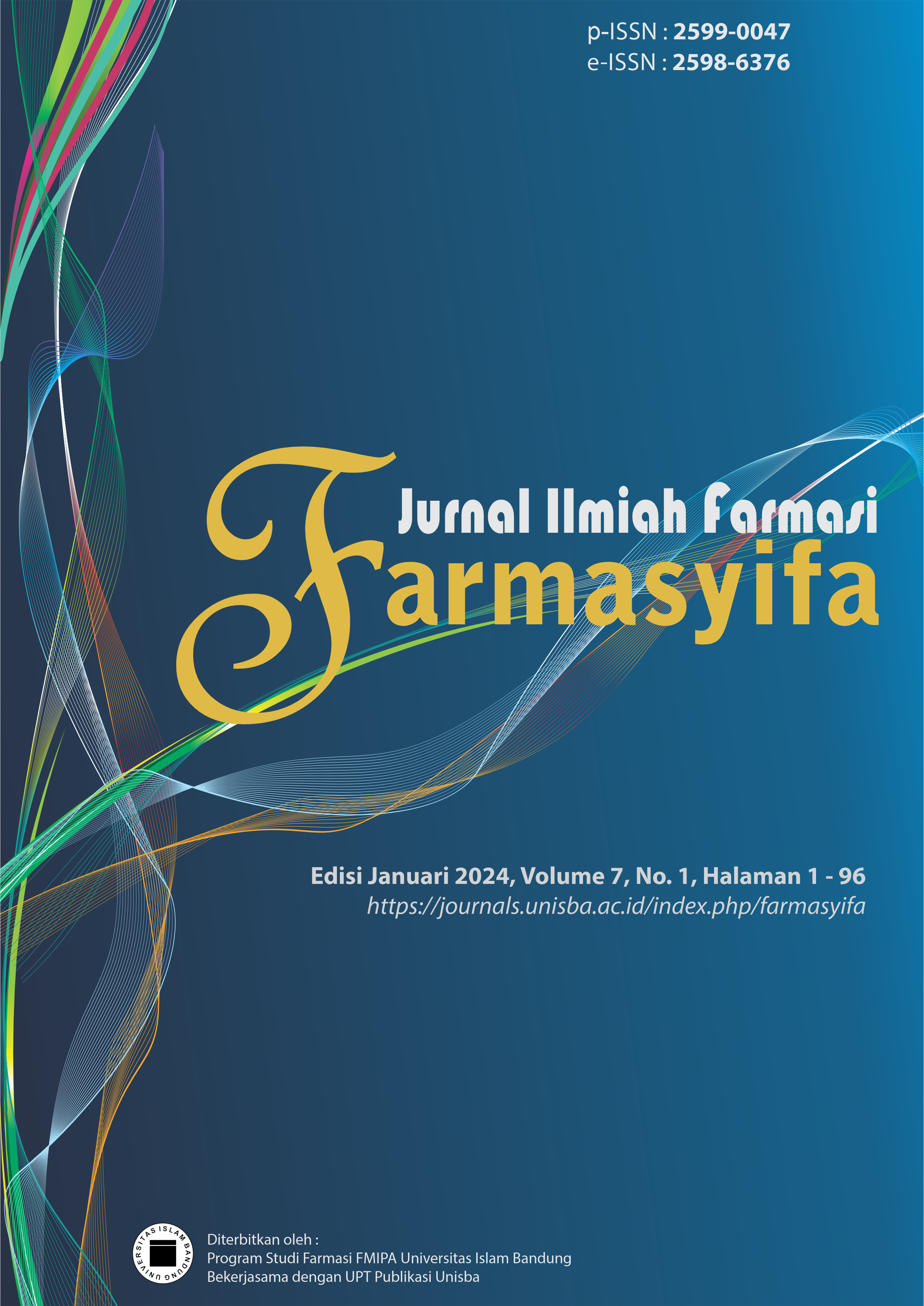IN-SILICO ANALYSIS OF TRANSMEMBRANE PROTEIN L1 HPV TYPE 52 FROM INDONESIAN ISOLATE
ANALISIS REGION TRANSMEMBRAN PROTEIN L1 HPV TIPE 52 ISOLAT INDONESIA SECARA IN-SILICO
DOI:
https://doi.org/10.29313/jiff.v7i1.3195Keywords:
Hydrophobic, L1 HPV 52, Transmembrane regionAbstract
The transmembrane region is the region of a protein that is inserted into the cell and has a hydrophobic tendency. One of these regions can be found in the L1 protein, which is a protein that makes up the human papillomavirus (HPV) icosahedral capsid. HPV (Human Papillomavirus) is a virus causing cervical cancer both nationally and globally. Cervical cancer is the third main cause of cancer in women globally and the first main cause in Indonesia. One of the most common types of HPV causing cervical cancer in Indonesia is HPV type 52, with the highest prevalence of around 23.2%. Development of a VLP-based vaccine using L1 HPV type 52 isolated from Indonesia is needed. VLP was the result of L1 protein assembly. However, L1 protein has a transmembrane region that is mostly hydrophobic and will usually form an aggregate. it will cause the targeted protein to settle in the water. Therefore, in this study, an analysis of the transmembrane region of the L1 HPV type 52 protein was carried out which had undergone cleavage of several bases at the N-terminal and C-terminal. The results showed that the recombinant L1 HPV type 52 protein, which is a truncated segment, did not have a transmembrane region when compared to the native L1 HPV type 52 protein.
Keyword: Hydrophobic, L1 HPV 52, and Transmembrane region
References
Chen XS, Garcea RL, Goldberg I, Casini G, and Harrison SC. 2000. Structure of Small Virus-like Particles Assembled from the L1 Protein of Human Papillomavirus 16. Molecular Cell 5: 557–567.
Cserzo M., Wallin, E., Simon, I., von Heijne G., and Elofsson, A.. (1997): Prediction of transmembrane alpha-helices in procariotic membrane proteins: the Dense Alignment Surface method, Prot. Eng., 10 (6), 673-676.
Evriarti PR, and Yasmon A. 2019. Patogenesis Human Papillomavirus (HPV) pada Kanker Serviks. Jurnal Biotek Medisiana Indonesia 8: 23-32.
Hanif, VR. 2018. Konstruksi Gen L1 HPV 52 pada PPICZA dan PPICZα untuk Ekspresi Protein Virus-Like Particles (VLP) pada Pichia Pastoris Gs115. [Skripsi]. Institut Teknologi Bandung, Bandung. [Indonesian]
ICO/IARC HPV information center. 2019. Human Papillomavirus and Related Desease Report, Available at: https://www.hpvcentre.net/statistics/reports/XWX.pdf, accessed August 2019.
Kirnbauer, R., Booy, F., Cheng, N., Lowy, D.R., dan Schiller, J.T., (1992): Papillomavirus L1 major capsid protein self-assembles into virus-like particles that are highly immunogenic. Proc. Natl. Acad. Sci. USA, 89, 12180–12184.
Li M, Cripe TP, Estes PA, Lyon MK, Rose RC, and Garcea RL. 1997. Expression of the human papillomavirus type 11 L1 capsid protein in Escherichia coli: characterization of protein domains involved in DNA binding and capsid assembly. J. Virol 71: 2988-2995.
Manor J, Feldblum ES, Zanni M, and Arkin IT. 2012. Environment Polarity in Proteins Mapped Noninvasively by FTIR Spectroscopy. J. Phys. Chem. Lett 3 (7): 939–944.
Pimienta, E., Rodriguez, R., Fando, Y., Serrano, D., Ortega, A., Palenzuela, K. dan Marrero, K. (2019): Cloning and expression in Escherichia coli of the full-length and deletion variants of a human papillomavirus 18 L1 gene isolated from a Cuban patient, Artículo Original.
Pusat Data dan Informasi Kementrian Kesehatan RI. (2015): Stop Kanker, INFODATIN Pusat Data dan Informasi Kementrian Kesehatan RI.
Touze A, Mahe D. El Mehdaoui S, Dupuy C, Combita-Rojas A, Bousarghin L, Sizaret P, and Coursaget P. 2000. The nine C-terminal amino acids of the major capsid protein of the human papillomavirus type 16 are essential for DNA binding and gene transfer capacity. FEMS Microbiology Letters 189: 121-127.
Vet, J. N. I., De Boer, M. A., Van Den Akker, B. E. W. M., Siregar, B., Lisnawati, Budiningsih, S., … Fleuren, G. J. (2008): Prevalence of human papillomavirus in Indonesia: A population-based study in three regions. British Journal of Cancer, 99(1), 214–218. https://doi.org/10.1038/sj.bjc.6604417.
Zhou J, Doorbar J, Sun XY, Crawford LV, McLean CS, and Frazer IH. 1991. Identification of the nuclear localization signal of human papilomavirus type 16 L1 protein. Virology 185: 625-632.
Downloads
Published
How to Cite
Issue
Section
License
Copyright (c) 2024 Henik Anjayati

This work is licensed under a Creative Commons Attribution-NonCommercial-ShareAlike 4.0 International License.






















